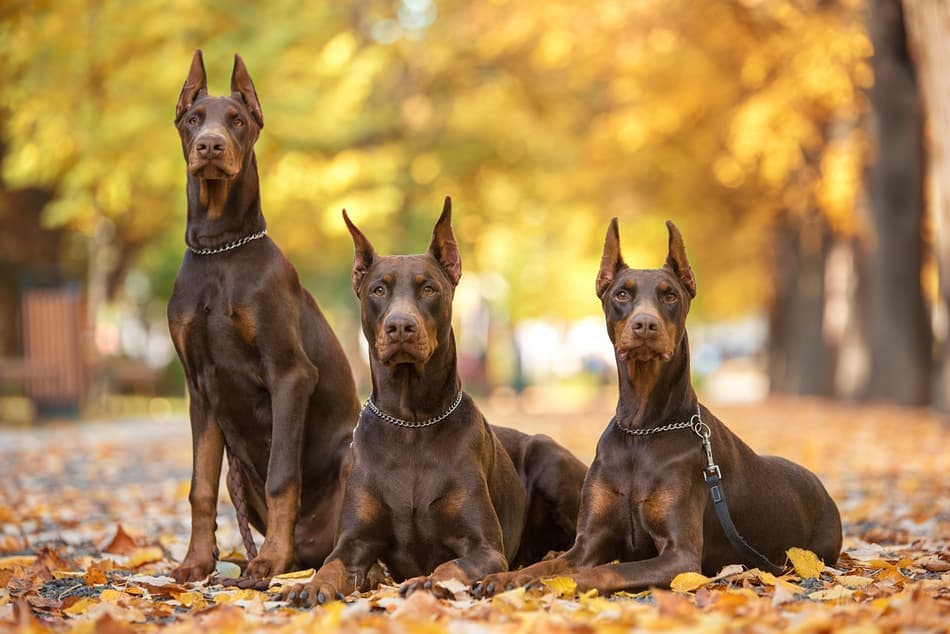When it comes to choosing the best Doberman, there are a few factors to consider. Did you know that this breed was developed in Germany by a tax collector named Louis Dobermann? Their sleek and muscular appearance, combined with their loyalty and intelligence, make them a popular choice for both working and companion dogs. But how do you determine which Doberman is the best fit for you?
In order to find the best Doberman for your lifestyle, it’s important to consider their training needs, energy levels, and temperament. Dobermans are known for their protective nature, so if you’re looking for a guard dog, the European Doberman might be the best choice for you. On the other hand, if you’re seeking a family pet who is good with children, the American Doberman may be a better fit. Understanding the history and characteristics of each type of Doberman can help you make an informed decision that will lead to a lasting and fulfilling relationship.
When it comes to choosing the best Doberman, consider factors such as temperament, health, appearance, trainability, and lineage. A well-bred Doberman with a balanced temperament, good health, and strong build is ideal. Look for reputable breeders who prioritize these traits. Additionally, consider the Doberman’s purpose, whether it’s for family companionship, guarding, or working. Ultimately, the best Doberman for you will depend on your specific needs and preferences.

Which Doberman is Best?
Dobermans are known for their loyalty, intelligence, and protective nature. However, with different variations within the breed, it can be challenging to determine which type of Doberman is best suited for your needs. In this article, we will explore the different types of Dobermans and discuss their characteristics and suitability for various purposes.
Standard Doberman
The Standard Doberman, also known as the American Doberman Pinscher, is the most common type of Doberman. This variety is known for its sleek and athletic build, making it an excellent choice for agility sports. Standard Dobermans are highly intelligent, trainable, and protective, which makes them ideal for family protection and guarding. They are known for their loyalty and devotion to their owners.
Standard Dobermans have a short coat that requires minimal grooming. They are typically black or dark brown with rust markings on the chest, paws, and face. Their average height is around 24-28 inches at the shoulder, and they weigh between 60-100 pounds.
If you are looking for a versatile and all-around Doberman, the Standard Doberman is an excellent choice.
European Doberman
The European Doberman, also known as the Doberman Pinscher, is a larger and more muscular variation of the breed. This type of Doberman is highly sought after for its imposing presence and strong protective instincts. European Dobermans have a more aggressive temperament compared to the Standard Doberman, which makes them well-suited for professional protection work and guarding.
European Dobermans have a deep chest, broad head, and a more robust physique. They are known for their endurance and agility, making them suitable for various dog sports and working roles such as search and rescue or police work.
While European Dobermans can be loyal and affectionate towards their families, they require experienced owners who can provide proper training and socialization. Due to their size and strength, they may not be suitable for novice dog owners.
Working Doberman
The Working Doberman is a specialized type of Doberman that is bred specifically for working roles such as search and rescue, therapy work, and service dog work. These Dobermans undergo rigorous training and screening to ensure they possess the necessary skills and temperament for their designated roles.
Working Dobermans are highly trainable, intelligent, and adaptable. They are known for their focus and ability to follow commands, which is essential for their working responsibilities. These Dobermans have a strong work ethic and excel in a structured environment.
While Working Dobermans can be excellent family pets, they require active and engaged owners who can provide them with mental and physical stimulation. These Dobermans thrive when they have a job to do and plenty of outlets for their energy.
Miniature Pinscher
The Miniature Pinscher, often referred to as the “Min Pin,” is not a true Doberman but shares similar physical characteristics and traits. This small and energetic breed is known for its playful and lively nature. While they may not possess the size or strength of the Standard or European Doberman, they make up for it with their bold and fearless personalities.
Miniature Pinschers are highly adaptable and can thrive in various living situations, including apartments. They have a high prey drive and require mental and physical stimulation to prevent boredom and destructive behavior.
While Miniature Pinschers may not be suitable for tasks that require size or strength, they are excellent companions and can excel in activities such as obedience, agility, and even small dog protection sports.
Which Doberman is Best for You?
The choice of which Doberman is best for you depends on your specific needs and lifestyle. Consider factors such as your experience with dogs, the purpose for owning a Doberman, and the amount of time and effort you can devote to training and exercise.
If you are looking for a versatile and loyal family pet that can excel in various activities, the Standard Doberman may be the best choice for you. Their balanced temperament and adaptability make them suitable for most households.
On the other hand, if you require a larger and more imposing Doberman for professional protection work or specific working roles, the European Doberman may be a better fit. However, they require experienced and knowledgeable owners who can provide them with the necessary training and socialization.
For those interested in participating in dog sports or working roles, the Working Doberman can offer the focus and drive needed for these activities. However, they are best suited for individuals with the time and dedication to meet their mental and physical needs.
Lastly, if you are looking for a smaller companion with a big personality, the Miniature Pinscher may be an excellent choice. While they may not possess the size or strength of the other types of Dobermans, they make up for it with their lively and fearless nature.
Key Takeaways: Which Doberman is Best?
1. The European Doberman tends to be larger in size compared to the American Doberman.
2. The American Doberman is often considered more energetic and playful.
3. The working line Doberman is known for its intelligence and trainability.
4. The show line Doberman is bred for its conformation and appearance in the show ring.
5. It’s important to research and meet different Doberman lines to find the one that suits your lifestyle and preferences best.
Frequently Asked Questions
Do you have questions about which Doberman is the best for you? We have answers to help you make an informed decision. Check out the frequently asked questions below to learn more.
1. What are the different types of Doberman?
There are two recognized types of Doberman: the American Doberman Pinscher and the European Doberman Pinscher. The American Doberman is typically larger and more muscular, while the European Doberman has a leaner build. Both types can make excellent pets, but their temperaments and physical characteristics may vary.
When choosing a Doberman, it’s important to consider your lifestyle and preferences. If you’re looking for a larger, more imposing dog, an American Doberman may be the right choice. If you prefer a slightly smaller and more agile dog, the European Doberman could be a better fit. Ultimately, the best Doberman for you will depend on your individual needs and preferences.
2. How do I choose the best Doberman for my family?
When choosing a Doberman for your family, there are several factors to consider:
– Temperament: Look for a Doberman with a stable and friendly temperament. Ideally, they should be good with children and other pets.
– Energy level: Consider the activity level of the Doberman. If you have an active family, a higher-energy Doberman may be a good fit. If you prefer a calmer dog, look for one with a lower energy level.
– Size: Determine if you want a larger or smaller Doberman based on your family’s preferences and living situation.
– Trainability: Assess the trainability of the Doberman. Look for a breed that is intelligent and responsive to training.
By considering these factors and doing your research, you can find the best Doberman for your family’s needs.
3. What health issues should I be aware of when choosing a Doberman?
Like all dog breeds, Dobermans are predisposed to certain health issues. Some common health concerns in Dobermans include:
– Dilated Cardiomyopathy (DCM): A heart disease that can lead to heart failure.
– Von Willebrand’s Disease: A bleeding disorder that affects the blood’s ability to clot properly.
– Hip Dysplasia: A condition where the hip joint doesn’t develop properly, leading to arthritis and mobility issues.
– Hypothyroidism: An underactive thyroid gland that can cause various health problems.
Prior to getting a Doberman, it’s important to find a reputable breeder who conducts health screenings on their breeding dogs. This can help minimize the risk of these health issues. Regular veterinary check-ups and a healthy diet and exercise routine are also important for maintaining your Doberman’s health.
4. How much exercise does a Doberman need?
Dobermans are an active breed and require regular exercise to stay happy and healthy. On average, they should get at least 1-2 hours of exercise per day. This can include activities such as walks, runs, playtime, and mental stimulation through training sessions or puzzle toys.
It’s important to note that Dobermans are not well-suited for apartment living without access to regular exercise. They thrive in homes with fenced yards or access to open spaces where they can run and play. Failure to provide adequate exercise can lead to behavioral problems, such as excessive barking or destructive chewing.
5. How can I ensure my Doberman becomes well-behaved and obedient?
To ensure your Doberman becomes well-behaved and obedient, consistent training and socialization are key. Start training your Doberman from a young age and use positive reinforcement techniques, such as rewards and praise, to encourage good behavior. Consistency is important to establish boundaries and expectations.
Additionally, socialize your Doberman with people, other animals, and various environments from a young age. This helps them develop good manners and reduces the likelihood of behavioral issues, such as aggression or fearfulness, later in life. Enrolling in obedience classes or working with a professional dog trainer can also be beneficial in teaching your Doberman proper manners and obedience.

When it comes to determining which Doberman is best, it all boils down to individual preferences and specific needs. Doberman Pinschers are renowned for their loyalty, intelligence, and protective nature. If you’re looking for a Doberman for personal protection, the European Dobermans are often favored for their size and working abilities.
On the other hand, if you’re seeking a Doberman as a family pet, the American Dobermans are known for their friendly and sociable temperament. Both varieties have their unique qualities and excel in different areas, so it’s crucial to consider your own requirements and research reputable breeders to find the perfect Doberman for you.
